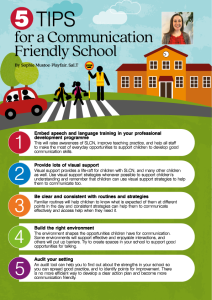QUESTION: What does it mean to be a ‘Communication Friendly Setting’ and how can I achieve this in my school?]
ANSWER: A communication friendly school has an environment which makes it easy, effective, and pleasant for all members of your school community to communicate with one another. The goal is for all children to be able to express themselves clearly, understand others, and participate fully at school.
Simple adjustments to the environment will boost communication, but for these to have real impact they must be applied consistently across the whole setting. This means support for SLCN does not stop at the classroom door, and children will be supported in developing their communication skills at every opportunity throughout the day.
Here are 5 ways to help your school become communication friendly
1) Training for staff
All members of staff can benefit from developing their understanding and knowledge of speech and language. This knowledge can be applied in every interaction with a child to support the development of functional communication skills. Training should focus on raising awareness of SLCN and core classroom support strategies and how staff can adapt the language they use so that it doesn’t become a barrier to a child’s participation. Having one ‘communication champion’ in your school, with a special interest in SLCN, can ensure best practice is followed throughout the school.
2) Visual support
This helps to alleviate the pressure for children with SLCN (and it’s helpful for children with a range of other difficulties too!). Use pictures, symbols, photographs, gestures or signs, demonstrations, colourcoding, and even the written word. Remember that visual support isn’t a one-way street: interactive displays, such as working walls, confidence indicators and communication boards can help children become active participants in their own learning.
3) Be clear and consistent
All children should be familiar with daily routines and with the expectations you have of them. Consistency throughout the whole school is important, not only for applying rules and behaviour management, but so that children know how to interact and participate. Children should be able to anticipate the strategies that will be applied in different classrooms and know how they can access help. They should have reliable opportunities and strategies to use to say when they don’t understand or need support.
4) Places and spaces
Consider adapting spaces around your school to encourage quiet communication by creating comfortable spaces to talk in different situations and for different purposes. You could rearrange the furniture in different places to facilitate a variety of opportunities for talking.
5) Audit your setting
Carry out a communication audit for the setting, taking account of the practice observed within classrooms and in shared areas, the features of the environment, policies, and staff training. Using audit tools and communication friendly checklists can help you to develop a clear action plan to boost the inclusivity of your setting.
Download our 5 Tips for a Communication Friendly School Poster here.

Please login to view this content
Login